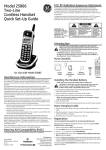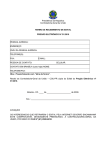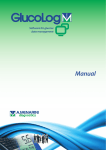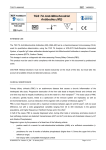Transcript
GLC ELECTRODES GLUCOSE ELECTRODES ENG Reagent strips for the determination of glucose concentration in whole blood To be used only with the 3in1. Instructions for use Introduction The self-checking of the glycaemia allows the diabetic patient to have immediate information about his/her glucose level, but it must be performed only after accurate training with a physician or with a qualified technician. It is important to point out that the self-checking cannot be performed without constant follow up by the physician (to make up a timetable, to evaluate the results and to define a therapy). Test principle The glucose level in the blood is measured by the instrument electronically . The glucose contained in the sample reacts with the glucose oxidase enzyme generating electrodes. The electrical currency produced by electrodes is directly proportional to the glucose concentration. Composition The reactive area of each strip contains: Glucose Oxidase: > 21μg; mediator (Hexaammineruthenium chloride): 139 μg; Buffer: 5,7 μg; > stabilizer: 86 μg. Procedure •Open the pack of 3in1. Glucose electrodes strips, pull out the data-chip of blue color. •Insert the data-chip into the proper space on the side of the meter (picture 1). •Open the vial, take a strip and immediately close it. •Insert the strip in the strip holder of the meter (picture 2), with the arrows in the direction of the meter till to hear an acoustic signal (”bip”). •Check that GLC EL symbol appears on the display and check that the number on the strip vial label is the same of the one on the display (picture 3). •Perform the finger pricking using the lancing device 3in1., contained in the pack of the meter, and a sterile lancet. •Gently press the finger to obtain a second droop of blood (1 microliter). •Approach the pricked finger with the droop of blood to the lower part of the strip (it is the part that comes out of the instrument). The sample of blood will be automatically aspirated by the strip and the instrument will emit an acoustic signal (“bip”) (picture 4). •After 5 seconds the result will be displayed •Use the ejector key on the backside of the meter to remove the used strips in order to avoid contaminations. Only one measurement has to be carried out for each finger pricking! Carefully follow the instructions contained in the user manual. All components of the pack has to be disposed properly, avoiding contaminations. Checking the system To test the user’s skill, the 3in1. Glucose ELECTRODES system performance and its reactive strips, a periodic check should be carried out using the 3in1. Glucose ELECTRODES control solutions as described in the instructions contained in the package. The glucose concentration intervals are printed on the labels of the reagent strips’ vial. Storage and expiry date Keep the reactive strips at temperatures between 5°C (41°F) and 30°C (86°F) and keep them in the original vial. Do not expose to direct sun light. Close the vial with the original cap immediately after pull out the strip. In this way, the strips will last up to 3 months after the first opening. The expiry date on the package of strips refers to a new unopened vial. The use of expired strips can cause wrong results. Do not expose to excessive humidity. Do not freeze!! Normal Values at fasting 3.9 - 6.1 mmol/L (70-110 mg/dL) Table of results Glucose below 0.6 mmol/L (10 mg/dL) = LO* Glucose between 0.6 mmol/L (10mg/dL) in 33.3 mmol/L (600 mg/dL) = the numerical result Glucose above 33.3 mmol/L (600 mg/dL) = HI** *Repeat the test. **Such results mean that the glucose concentration in the sample is very elevated and it indicates a serious risk. Contact a phisycian immediately. The analytical results have to be communicated to the physician. The self-checking can be useful for the physician in order to formulate a diagnosis. Warnings •Do not perform tests at temperatures below 10°C (50°F) or above 40°C (104°F) and humidity lower than 10% or more than 90%. •Use the strip immediately after removing it from the vial. Note for the physician and laboratory technicians To measure the Glucose with the 3in1. system it is possible to use fresh capillary blood. Do not use serum or plasma on the strip. If you want to use venous blood on the strips, check that the pO2 value is inside the range 40-60 mmHg and contact the manufacturer anyway. •For the test with 3in1. Glucose ELECTRODES you have to use only capillary blood. Do not use serum or plasma. •Hematocrite range: 30-55%. Values higher than 55% can give false low results and values lower than 30% can give false high results. If you don’t know the hematocrite value ask your physician. •Interferences: acetaminophen, uric acid, ascorbic acid (vitamin C) aqnd other educing substances (when occurring in normal blood or normal therapeutic concentrationa) do not significantly affect the results. However abnormally high concentrations in blood may cause inaccurately high results. •Lipemic samples, cholesterol up to 12.93 mmol/L (500 mg/dL) or tryglicerides up to 6.74 mmol/L (600 mg/dL) do not affect results, but the values obtained with that samples have to be carefully considered. •Blood samples that contain a high concentration of dissolved oxygen may lower test result. •Tolazamide, gentistic acid treatment may increase the test result •Antiglycolysis and anticoagulants in blood samples may affect the test resuls. Correlation results between different anticoagulants are available. Limitations •The system is optimised for capillary analysis. •Repeat the test if the glucose value obtained does not correspond to the sensations felt by the patient or to the basic knowledge of health conditions and symptoms. Consult the user manual to verify the correct procedure, otherwise consult your physician. •Inaccurate results may occur when in shock, hypotensive individuals, hyperglycemic, or hyperosmolar state, with or without ketosis. •If glucose values below 2.7 mmol/L (50 mg/dL) or above 13.8 mmol/L (250 mg/dL) are obtained, consult a physician as soon as possible. •In the case of severe dehydration and excessive water loss the tested values can be significantly inferior in respect to the real values. •Inaccurate results may be obtained at altitude higher than 3000 meter (10000 feet). Accuracy The 3in1. Glucose ELECTRODES system average error compared to the reference value is <10%. In a series of measurements performed in hospital, the following linear regression has been obtained: Y=0.9895x-1.7404. Precision Repeatability: maximum imprecision is <5%. In a series of measurements performed in laboratory an average coefficient of variation 3.8% was obtained. Reproducibility: maximum imprecision is <5%. In a series of measurements performed in laboratory an average coefficient of variation 3.5% was obtained. Minimum blood sample volume: 1 μL. Important Informations About Using Other approved sites Blood Samples 1. 2. 3. 4. 5. 6. 7. 8. 9. 10. Other approved sites can be your forearm, upperarm, thigh, calf and palm. Consult your physician before you begin using the other approved sites for testing. Testing during or after meal, physical exercise, or any other events that will impact glucose level can alter your blood glucose test results. It may significantly differ from the other appoved sites and fingertip samples. (Blood Glucose levels change more ralidly in the fingertips than it does in the other approved sites). Other approved sites testing should only be used two or more hours after meals, phisical exercise, or any other events that may affect blood glucose levels. (testing within those two hours should be obtained through yuor fingertip). Testing with a fingertip sample may identify a hypolglycemic (low blood sugar) level sooner than a test the other approved sites sample. Use fingertip samples when you are concerned with hypoglycemia (insulin reactions) such as when you are driving a car, particulary if you suffer from hypoglycemia unawareness (lack of simptoms to indicate an insulin reaction), as other approved sites testing may fail to detect hypoglycemia. Use fingertip samples when the results from other approved sites do not agree with the way feel. Other approved sites samples testing is NOT recommended for people with a history of recurrent hypoglycemia. Routine testing before meals can be done either at the fingertip or other approved sites. CE mark Use until ... Control Solutions In Vitro Diagnosticum Batch number Level 1 Store at ... Follow instructions Level 2 VPD Bled d.o.o. Pot na Lisice 4, 4260 Bled, Slovenia tel: ++386 4 574 50 70 fax: ++386 4 574 50 71 In vitro diagnostika IN TGL ED2009 REV01-E-SL





















